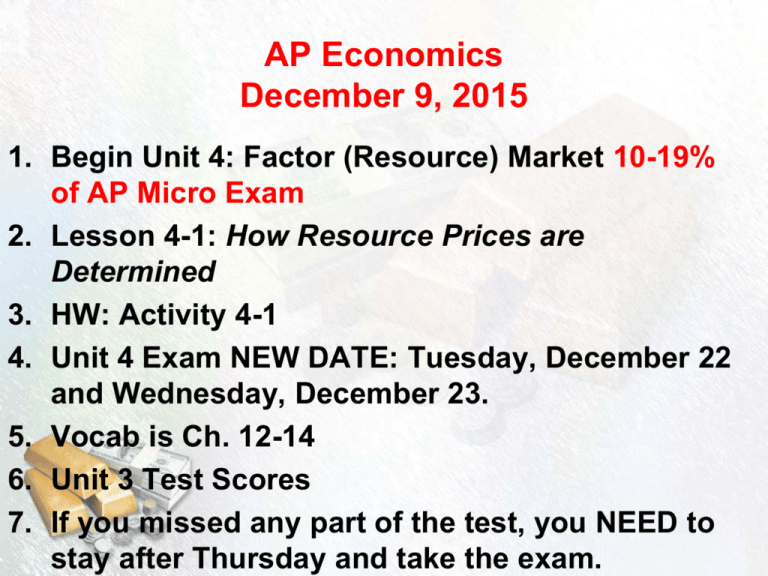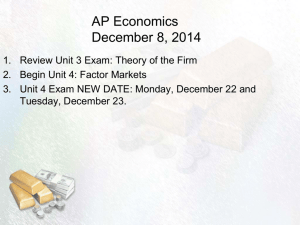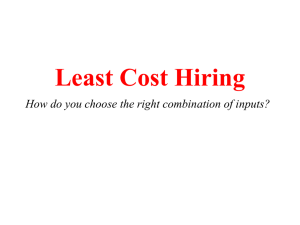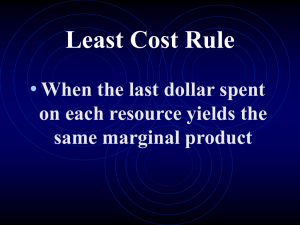File
advertisement

AP Economics December 9, 2015 1. Begin Unit 4: Factor (Resource) Market 10-19% of AP Micro Exam 2. Lesson 4-1: How Resource Prices are Determined 3. HW: Activity 4-1 4. Unit 4 Exam NEW DATE: Tuesday, December 22 and Wednesday, December 23. 5. Vocab is Ch. 12-14 6. Unit 3 Test Scores 7. If you missed any part of the test, you NEED to stay after Thursday and take the exam. Factor/Resource Market: Firm is a Seller and a Buyer The Demand for Resources • Factor of production is something (input) that is used to produce output. • Examples: buildings, machinery, land, labor, raw materials. • Derived Demand: The demand for an input is derived from the demand for the output that the input produces. MRP & MRC • Marginal Revenue Product (MRP): Change in Total Revenue that results from the employment of an additional worker. • MRP = DTR / DL • Marginal Resource Cost (MRC): change in Total Cost that results from employment of an additional worker. • MRC = DTC / DL • A firm maximizes its total profit by EMPLOYING AMOUNT OF RESOURCES SO THAT: MRP=MRC! MRC in: Perfectly Competitive Labor Market • Each time a firm hires another worker, its cost increases by the price of the labor (PL) • For a firm in a perfectly competitive labor market, MRC = PL (MRC=Wage) • (If a firm is not in a perfectly competitive labor market, this is not true.) The Supply Curve of Labor to a Firm that is IN Perfect Competition in the Labor Market Firm is a Wage-Taker Price of Labor PL S Labor Warm-Up Review Quantity of Labor Total Product (Pizzas) 0 0 1 5 2 12 3 16 4 17 5 15 • Assume labor in the Factor Market is perfectly competitive and assume pizzas are sold in a perfectly competitive product market. 1. How many workers should the pizza making firm hire if Wage is $20 and pizza sells for $10? 2. What will be the total labor cost? 3. What will be the firm’s profit? Warm Up Answers Q TP MP TR MRP (MP x Price) MRC 0 0 - - - - 1 5 5 50 50 20 2 12 7 120 70 20 3 16 4 160 40 20 4 17 1 170 10 20 5 15 -2 150 -20 20 Total labor cost is 3 x $20 = $60 Total revenue is 16 x $10 = $160 Total Profit is $100 Lesson 4-2: Optimal Combination of Resources • So far, we assumed the firm was operating in the Short Run with fixed capital and labor as its variable resource. • Long Run: Firm can change its capital (K) and it labor (L) • Q: What combination of L & K should the firm employ? • We can Minimize Cost or Maximize Profit… The Least Cost Combination • • If a firm wants to produce the most output on a given budget…or…if it wants to produce a specific level of output at lowest cost to maximize profit, it uses the Least Cost Combination. Economic Efficiency: Firm should get SAME EXTRA OUTPUT ON LAST $ SPENT ON EACH RESOURCE Marginal Product Of Capital (MPK) Marginal Product Of Labor (MPL) = Price of Labor (PL) (MRCL) LO3 Price of Capital (PK) (MRCK) 12-10 Least Cost Practice Given the price of labor is $10 and the price of capital is $20, determine the cost minimizing combination. L TP K TP 1 12 1 22 2 22 2 34 3 30 3 44 4 36 4 52 5 40 5 58 What will be the Total Production? What will be the Total Cost? Least Cost Practice Given the price of labor is $20 and the price of capital is $40, determine the cost minimizing combination. L TP MP MPL/PL K TP MP MPK/PK 1 12 12 0.6 1 22 22 0.55 2 22 10 0.5 2 34 12 0.3 3 30 8 0.4 3 44 10 0.25 4 36 6 0.3 4 52 8 .02 5 40 4 .02 5 58 6 0.15 What will be the Total Production? 70 Units What will be the Total Cost? (4 x $20 = $80) + (2 x $40 = $80) = $160 Given the price of labor is $10 and the price of capital is $20, determine the cost minimizing combination of workers and capital. Assume the product being produced sells for $10 in a perfectly competitive product market and all inputs are operating in perfectly competitive product market. 1. 2. 3. 4. 5. L TP K TP 1 7 1 17 2 16 2 40 3 24 3 56 4 30 4 69 5 35 5 80 What is the cost-minimizing quantity of resources? What will be the Total Production? What will be the Total Cost? What will be the Total Revenue? What will be the Total Profit? Given the price of labor is $10 and the price of capital is $20, determine the cost minimizing combination of workers and capital. Assume the product being produced sells for $2 in a perfectly competitive product market and all inputs are operating in perfectly competitive product market. L TP MP MPL/PL K TP MP MPK/PK 1 7 7 0.7 1 17 17 0.85 2 16 9 0.9 2 40 22 1.1 3 24 8 0.8 3 56 16 0.8 4 30 6 0.6 4 69 13 0.65 5 35 5 0.5 5 80 11 0.55 What will be the Total Production? 24 + 56 =80 What will be the Total Cost? $90 What will be the Total Revenue? $160 What will be the Total Profit? $70 Profit Maximizing Rule • Least Cost Rule is necessary but not efficient… MRPL MRPK = 1 = LO3 PL PK (MRCL) (MRCK) 12-15 Profit Maximizing Practice Given an output price of $3 per unit, labor cost of $24 per unit and capital cost of $30 per unit, determine the profit maximizing combination of resources and the respective output level, revenue, cost, and profit. L TPL MPL MRPL MRPL/MRCL K TPK MP MRPK MRPK/MRCK K 0 0 0 1 12 1 22 2 22 2 36 3 30 3 46 4 36 4 54 5 40 5 58 Profit Maximizing Practice Given an output price of $3 per unit, labor cost of $24 per unit and capital cost of $30 per unit, determine the profit maximizing combination of resources and the respective output level and profit. L TPL MPL MRPL MRPL/MRCL K TPK MPK MRP MRPK/MRC K K 0 - - - - 0 - - - - 1 12 12 36 1.5 1 22 22 66 2.2 2 22 10 30 1.25 2 36 14 42 1.4 3 30 8 24 1 3 46 10 30 1 4 36 6 18 0.75 4 54 8 24 0.8 5 40 4 12 0.5 5 58 4 12 0.4 Total Output Level = 30 + 46 = 76 Total Revenue = $228 Total Cost = (3 x 24) + (3 x 30) = $162 Total Profit = $228 - $162 = $66







